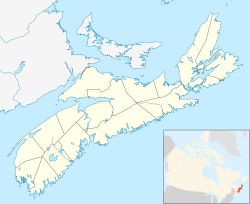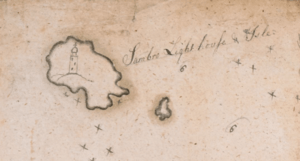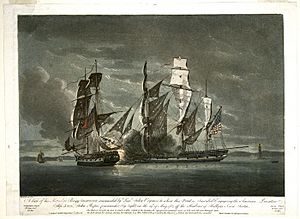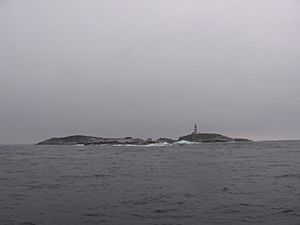Sambro Island Light facts for kids
 |
|
|
|
|
| Location | Sambro Island Halifax Nova Scotia |
|---|---|
| Coordinates | 44°26′12.5″N 63°33′47.8″W / 44.436806°N 63.563278°W |
| Year first constructed | 1759 |
| Year first lit | 1758 |
| Automated | 1988 |
| Construction | stone sheathed with wood shingles |
| Tower shape | tapered octagonal tower |
| Markings / pattern | white tower with three red horizontal bands, red lantern and trim |
| Height | 25 metres (82 ft) |
| Focal height | 43 metres (141 ft) |
| Original lens | rotating airport electric beacon |
| Range | 24 nautical miles (44 km; 28 mi) |
| Characteristic | Fl W 5s. |
| Admiralty number | H3632 |
| CHS number | CCG 507 |
| NGA number | 9968 |
| ARLHS number | CAN-442 |
The Sambro Island Lighthouse is a very important lighthouse located at the entrance to Halifax Harbour in Nova Scotia. It stands on an island near the community of Sambro. This lighthouse is special because it is the oldest lighthouse still standing in North America. Its construction is even considered a National Historic Event in Canada.
Contents
The Story of Sambro Lighthouse
The Sambro lighthouse was built a long time ago, during the Seven Years' War. The government of Nova Scotia decided to build it on October 2, 1758. To pay for it, they put a special tax on ships coming into the harbour and on alcohol. Before this, they tried to raise money with a lottery in 1752, but it didn't work.
Once the money was ready, building started in the fall of 1758. The stone work was finished by November 3, 1758. A temporary light was lit while they kept building. The lighthouse was fully finished in 1759. Joseph Rous became the first person to look after the light, called a keeper.
For many years, cannons were used to warn ships about fog. This started in the late 1700s. Later, in the 1870s, a steam fog whistle was put in place. The lighthouse became automatic in 1988, meaning no keepers were needed anymore.
The island where the lighthouse stands is at the mouth of busy Halifax Harbour. There are many rocks and hidden shallow areas around it. Because of this, many ships have crashed there over the years. One of the worst shipwrecks was the SS Daniel Steinmann in 1884. Out of 130 people on board, only nine survived. The lighthouse keepers helped rescue them.
In 1906, the lighthouse was made taller. Two more stories were added to the octagonal tower. A new, powerful lens from Paris was installed in November 1906. This lens helped the light shine even brighter. They also started making gas for the light in a special "gas house" built near the lighthouse. In 1908, red stripes were painted on the tower. This made it easier to see against the snow.
The Sambro Island Lighthouse was also a starting point for a famous journey. In 1895, Joshua Slocum began his solo trip around the world from here. He was the first person to sail alone around the world. He watched the lights disappear behind him as he sailed away from Sambro.
Sea Battles Near the Lighthouse
Because Sambro Lighthouse is at the entrance to Halifax Harbour, a very important port, it has seen many shipwrecks and sea battles.
During the American Revolution, there were several fights near the island. In December 1779, a ship called the Hope crashed near the lighthouse. Seven people died. Weeks later, two more British ships, the North and St. Helena, were wrecked in a storm. About 170 British sailors were lost.
In 1780, a British privateer ship called Resolution fought an American privateer ship called Viper near Sambro Light. A privateer was a private ship allowed to attack enemy ships. This battle was very intense. Both ships fired cannons at each other for about 90 minutes. The Viper eventually captured the Resolution. But the Americans lost 33 lives, while the British lost 18.
Another battle happened in May 1782. The American privateer Jack fought the British transport ship Observer. The battle lasted all night and into the next day. The British Observer captured the American Jack.
In September 1782, an American privateer ship called Wasp sailed to Pennant Point. Some men from Sambro fired at them, killing one crew member and hurting three others. The privateers then buried their crew member on an island.
During the War of 1812, an American privateer called Young Teazer captured two ships near Sambro Island Light in May 1813. British warships chased the Young Teazer. To avoid being captured, the privateer was blown up, and many lives were lost.
In World War I and World War II, German submarines attacked Allied ships near Sambro. For example, in World War II, on December 24, 1944, a Canadian ship called HMCS Clayoquot was hit by a torpedo from a German submarine. It sank quickly, and eight lives were lost.
Recent Times at the Lighthouse
In 1966, the old powerful lens was replaced with a new electric light. This new light was powered by an underwater electrical cable. The old lens was saved and is now at the Maritime Museum of the Atlantic. The last lighthouse keepers at Sambro left in 1988. Since then, no one lives on the island.
There were three houses for the keepers, built in the 1960s. One was taken apart in 1989. Another burned down in 2007. The third has been left to fall apart. The Nova Scotia Lighthouse Preservation Society has worked to protect the buildings on Sambro Island. They helped get the lighthouse tower declared a special federal heritage building. The old Gas House was also recognized as a heritage building in 1996.
Major repairs were done to the lighthouse in 1998. It was re-shingled and repainted. In 2003, Hurricane Juan caused a lot of damage to the Gas House. Even though it's a heritage building, the Canadian Coast Guard has not repaired it. Many people are concerned that Canada's oldest lighthouse is being left to decay.
In October 2007, the underwater power cable was damaged. The Canadian Coast Guard turned off the fog horn. This ended over 200 years of fog warnings from the island. They planned to use only solar power for the light. This caused protests from sailors and heritage groups. They wanted the fog horn to stay on and the lighthouse to be cared for. In response, a larger solar system was installed in 2008. This system powers both the light and a foghorn. The tower was also repainted.
On August 16, 2008, the community of Sambro Harbour and the Nova Scotia Lighthouse Preservation Society celebrated the lighthouse's 250th birthday. About 150 people visited the island for talks and tours. Sadly, one of the empty keeper's houses was destroyed by a suspicious fire in September 2008. This raised more worries about the other old buildings on the island.
Where is the Lighthouse?
The lighthouse is on top of Sambro Island, which is about half a kilometer square. It's located on the west side of the entrance to Halifax Harbour. This is about 6 kilometers southeast of Sambro Harbour. The area around it has many dangerous shallow areas and rocks.
The Canadian Coast Guard owns and takes care of the lighthouse and the island. Besides the old stone tower from the 1700s, there's also the old wooden Gas House from the 1800s, which is in danger of falling apart. There's also a fog horn shed that is not in good condition. You can also see the ruins of the keeper's houses from the 1960s. Some old cannons, once used for fog signals, are near the tower.
A cool rock formation called "The Devil's Staircase" can be seen near the lighthouse. It's a unique intrusion dike. The huge lens that was used in the lighthouse until 1968 is now on display at the Maritime Museum of the Atlantic in Halifax. You can get good views of the lighthouse from Crystal Crescent Beach and Sandy Cove near Ketch Harbour.
The Canadian Coast Guard usually doesn't encourage tours of the island. However, since 2008, the Nova Scotia Lighthouse Preservation Society and the Sambro community have offered special open house tours once a year. A local fishing company also started offering visits to the island by appointment.
Remembering the Lighthouse
The Sambro lighthouse was named a National Historic Event in 1937. There's a plaque and a stone monument near the United Church in Sambro Harbour to mark this. The large lens that worked at Sambro from 1906 to 1968 is now at the Maritime Museum of the Atlantic in Halifax. The electric light that replaced it from 1968 to 2007 is also there.
The lighthouse tower was named a "Classified federal heritage building" in 1996. The Gas House was named a "Recognized heritage building" in the same year. In 2004, the Royal Canadian Mint made a special $20 silver coin featuring the lighthouse. Canada Post also released a permanent stamp honoring the Sambro lighthouse in December 2007.
Lighthouse Keepers
- Joseph Rous (1758)






